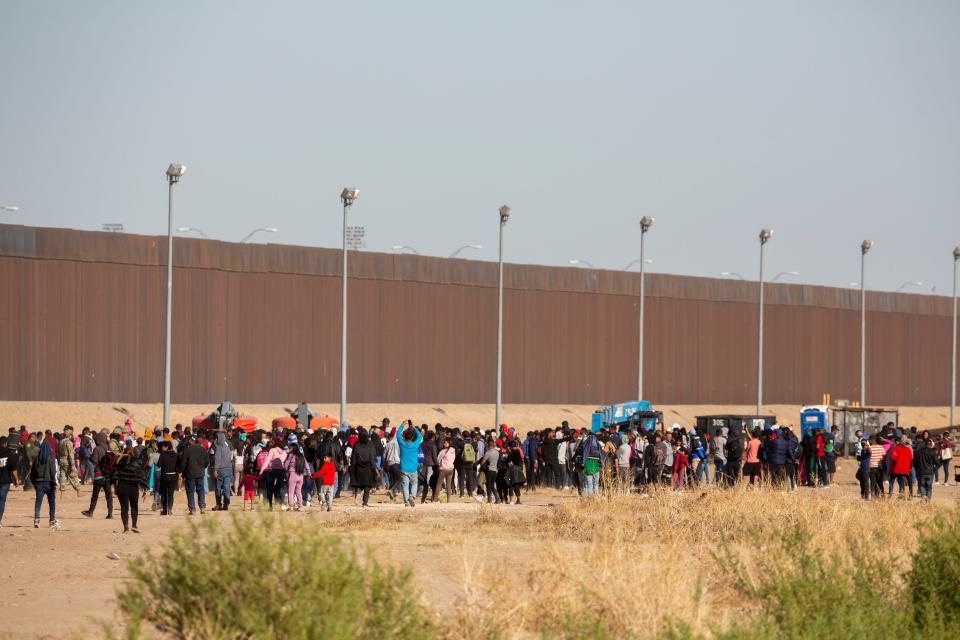How will El Paso handle the end of Title 42? Border Patrol chief shares his plans
U.S. Border Patrol's El Paso Sector could face a surge in asylum seekers and other migrants as the end of quick expulsions at the border nears.
When Title 42 authority expires in May, Border Patrol will return to processing migrants at the U.S.-Mexico border under the nation's Title 8 immigration law. The Title 8 immigration law includes a range of provisions, from asylum procedures to criminal immigration prosecutions.
The Title 42 public health law was invoked by the Trump administration in March 2020 during the pandemic, and the quick-expulsions authority is expected to end when the Biden administration lets the national COVID-19 emergency lapse on May 11.
Border Patrol El Paso Sector Chief Scott Good, who took over the sprawling sector last month, is tasked with guiding how agents manage the flow of migrants at the border in West Texas and New Mexico. The sector includes more than 260 miles of U.S.-Mexico border from the urban footprint of El Paso through the rural ranchland of New Mexico to the Arizona state line.
El Paso has had the highest level of irregular crossings of any sector at the border for the past six months. Border Patrol reported more than 30,000 encounters each in January, February and March after logging 50,000-plus encounters per month last year.
The sector, staffed with roughly 2,400 Border Patrol agents, is receiving additional personnel from other sectors and contract assistance at its holding facilities, Good said, to bolster staffing ahead of the Title 42 expiration.
Good spoke to the El Paso Times about preparations for the end of Title 42, new asylum processes, plans to stave off a humanitarian crisis and the consequences migrants may face if they cross the border unlawfully. The following is an excerpt from the conversation.
How does El Paso Sector plan to handle the coming end of Title 42 expulsions?

The good news is we have a plan. There is a plan in place and we've already started working on that plan. If you look back to what we had even a year ago, we've dramatically increased our capability here.
We had just a Central Processing Center, and now we have a soft-sided facility that's just as big. That’s a 20-acre site. In June, we're also going to get another soft-sided facility right next to that. So as far as capacity (to detain migrants), that's increased.
Going away from Title 42, we go back to Title 8. We've been using Title 8 for a long time.
More: What is Title 42, when does policy expire and how does it impact border? What to know
Title 8 provides for asylum protections as well as criminal consequences for crossing the border unlawfully. How do you plan to apply Title 8 here?
We'll be doing more coordinated efforts.
For example, (U.S. Citizenship and Immigration Services) will be providing at least three asylum officers. We'll provide the migrants a space kind of like a booth. I think there are 36 or 38 booths that we have right now where they can have privacy and talk to representation and go through that process in conjunction with USCIS (U.S. Citizenship and Immigration Services) to adjudicate their credible fear claims right there. We've been doing this along the Southwest border now for at least a week, getting ready for it, just kind of working out the bugs. So far it is working, and it will mean longer detention times.
Then, as far as using Title 8 as an enforcement measure or a tool: We’ll be focusing on those authorities, especially when you look at migrants who are trying to evade (apprehension). We've had a lot of migrants trying to evade and that comes with people who destroy property and put people's lives at risk.
The U.S. Attorney's office in West Texas, they're dedicating some prosecutors to a team. We really want to make an impact and stop bad people from doing bad things. And it seems like (prosecutions) even ramping up on the New Mexico side, as well.
More: What is Title 8? What to know about the nation's immigration law and border enforcement
Is this sort of collaboration between Border Patrol and U.S. Citizenship and Immigration Services on asylum adjudication new?
It's happened before, but not on a large scale. I think you're going to see it across the Southwest border this time. There are just such large volumes of people right now. So I think we're seeing more support than we ever had before.
The city of El Paso remains concerned about large numbers of migrants being released directly to the street. How are you preparing to stave off a humanitarian crisis like what we saw in 2022?
I've met with the mayor on that particular issue. That's a concern for everyone. We have a prioritization. Our priority is always enforcement and removal.

We're not really designed for, nor should we be, holding people for long periods of time. (U.S. Immigration and Customs Enforcement) is the entity that has that mission, but they can reach capacity levels. And so that's when we start going into decompression by going to other sectors. There are 20 sectors in the Border Patrol, but there are nine on the Southwest border that really have that kind of capacity to help out with flights or busing to the other sectors to help that decompression.
The third option would be NGOs. Ruben Garcia’s Annunciation House, some religious organizations also, will help out. The county, as well as the city, have plans to be able to provide shelter if it comes to that. Our very last choice is those safe street releases, where we would try to take them somewhere if we just can't hold any longer and there's no other option. It might be a bus station or somewhere where they can travel out.
What is the message from Border Patrol right now to migrants waiting in Juárez?
The message is not to cross. It's they need to go to a safe place and wait and use the (CBP One) app.
There's going to be repercussions for a lot of folks who don't use the app. If you didn't use the app and you’re adjudicated as not having a valid, credible fear claim and are not granted asylum, you could be prohibited from coming into the country for five years. So there are consequences. A legitimate asylum claim should come through the port of entry.
More: An abandoned building that became waiting room to US for migrants
(There are people) passing out false information on social media. We do the best we can with videos and social media and stuff, but it does get drowned out by bad actors who are trying to just make money.
Crossing the border illegally is wrong, and there are going to be consequences. That's our focus: to provide as many consequences as we possibly can to ensure the safety of the nation, my agents working there on the line, as well as the migrants.
Lauren Villagran can be reached at lvillagran@elpasotimes.com, on Twitter @laurenvillagran and Instagram @fronteravillagran.
This article originally appeared on El Paso Times: Border Patrol Chief Scott Good talks Title 42 end date in El Paso

